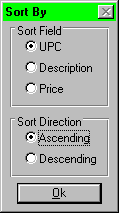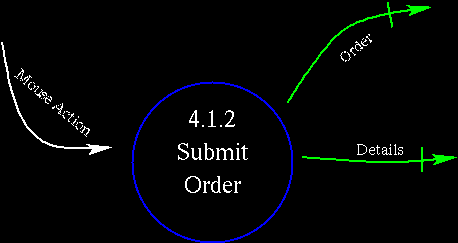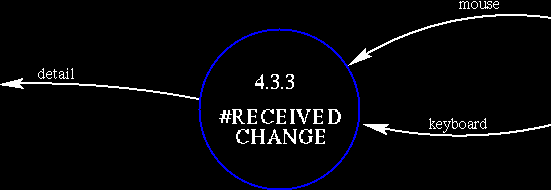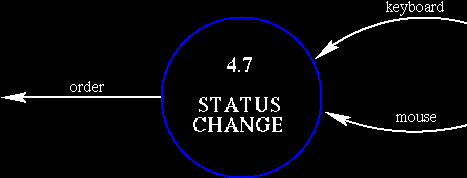|
|
|
|
 Clicking the Orders button on the main menu will bring up the orders screen.
This consists of a table which contains all of the orders currently in the
system as well as some buttons for manipulating orders. Any employee can
enter the orders screen and use the SEARCH, SORT BY and
PRINT functions, but only those with security access can
modify or create orders.
Clicking the Orders button on the main menu will bring up the orders screen.
This consists of a table which contains all of the orders currently in the
system as well as some buttons for manipulating orders. Any employee can
enter the orders screen and use the SEARCH, SORT BY and
PRINT functions, but only those with security access can
modify or create orders.
Anybody without proper security will find all the buttons except for SEARCH, SORT BY, PRINT and EXIT grayed out. A possible future change to the system would allow the orders table to be archived on paper and disk, say, every month. For now, the orders database will just continue to grow indefinitely.
The table will have 5 columns - order number, date ordered, employee number, status and date completed. The order number is what the table is initially sorted by, with the highest number (most recent order) first. Employee number is used to tell who made the order. The status of the order can be one of the following: pending (an order that has been sent to the warehouse), filled (an order that has been filled by the warehouse and sent to the store), complete (the store receives the complete order), and incomplete (part of the order is missing or damaged). Date completed refers to the date that the order was given a status of completed.

The buttons beneath the table consist of the following:
- MANUAL
-
By using the mouse to click on the MANUAL button on the orders
menu, a user begins the process of creating a new order.
The first event which occurs is the displaying of the MANUAL ORDER interface. The MANUAL ORDER interface screen is set up as follows:
At the top of the interface screen is a section which displays all of the information which is saved in conjunction with an order. This includes:
- The current date and time
- The employee ID
- The order number
- The store ID
Each of these are set automatically.
The middle section of the MANUAL ORDER interface screen is where items can be placed on an order.
There is a table on the left which displays a listing of every grocery which is carried by the warehouse. The items are displayed in order of UPC number, and the quantity that the store has in stock, as well as the description of each one is given. This table has the following functionality:
- The table will only display groceries if they fall into a category to which the user has security access to. Thus, a meat manager will not be given the opportunity to accidentally order produce, and a pharmacist will not be able to place an order for baked goods.
-
A scroll bar on the right edge of the table is used to
manually search through the list.

- A find button below the table brings up a dialogue box where a user can enter a UPC number or a brief description, and the table will automatically scroll so that the indicated UPC number or description is displayed.
- A sort button below the table allows the user to select whether the list should be displayed in order of UPC number, or in alphabetical order of Description.

A second table on the right of the groceries table displays the actual order being made. The items are displayed in order of UPC number, and the quantity ordered is also listed. This table has the following functionality:
- A scroll bar on the right edge of the table is used to manually search through the list.
- Below the manual order table is a SUBMIT button. When the order is done, the user clicks this button to have the order processed. This adds the order to the orders database and updates the big orders table on the previous screen. After the order has been submitted, the MANUAL ORDER window disappears.
A right arrow button to the left of the table increments the number of items to be ordered. The item highlighted on the Groceries table is what is affected on the Order table. If an item is not listed on the order table, it is added to the table, and the quantity is set to 1. Each subsequent time this button is clicked on, the quantity increases. By clicking and holding on the button, the quantity can be raised very quickly.
A left arrow button to the left of the table decrements the arrows. If the highlighted item on the Groceries table is not listed on the Order table, no action results from clicking on this button. If there is a quantity of one given for the highlighted item, clicking on the left arrow button removes that item from the order form. Otherwise, the quantity is reduced by one. By clicking and holding on the left arrow button, the quantity can be lowered very quickly.
Lastly, in the bottom-right corner of the table, a CANCEL button is displayed. When the user clicks this button, the current MANUAL ORDER is discarded, and the MANUAL ORDER interface screen disappears, replaced by the ORDERS interface screen.







- DETAILS
-
The orders database only stores the order number, date ordered, the
employee who ordered it, the order's status and the date completed.
A separate database, groceries ordered, is need to record the
details of each order. These details consist of the breakdown of
every item that was in that order - including the UPC, description,
the number ordered and the number received. To access this
information, the user highlights a particular order and then clicks
on the details button. This brings up the details window which will
display the above information for the given order in a scrollable
table.
The number received is the only changeable field on the table. If
an order is marked incomplete (on the orders screen previous to
this) then it is necessary for the user to enter the details screen
and fill in how many of each individual item in the order was
received. The details screen will automatically pop up when an
incomplete is entered. The user then enters the number received by
clicking on the correct field and then entering the number received
directly into the field. If an order was marked complete on the orders
screen, then the numbers in the number received column will
automatically be set to match the numbers in the number ordered
column. If an order status is set to "filled" by the warehouse then
an invoice for the order is automatically generated to be shipped
with the order to the store.
- EXIT
- This returns the user to the Orders Interface screen. If changes have been made to the details screen, but the database hasn't been updated, a message will come up asking the user if he/she wishes to save the changes.




- FIND
-
This button allows the user to find a certain order or orders.
A FIND dialogue screen will come up which allows the user to enter
various criteria. The user will be able to search on any field(s)
in the database. For instance, the user should be able to search
for a single order by order number, or for all orders made in the
previous month by a certain employee and containing squid.

- SORT BY
-
This button allows the user to sort the table of orders based on
any column in the table. The following sorts will be used:
- order number: highest (most recent order) to lowest (least recent order)
- order number: lowest (least recent order) to highest (most recent order)
- employee number: lowest number first
- status: sort by type: complete, incomplete, pending, filled.

-
This button prints out all the orders in the orders database.

- AUTO ORDER
-
This button starts allows the user to access the automatic ordering process. It brings up a dialogue box with the following features:
- Time: The user can set the time that the Automatic Ordering system will execute every day.
- Order Now: The user can start the Automatic Ordering system executing immediately.
- Cancel: The user can leave the Automatic Ordering interface, any changes made to the time will be ignored.
- Okay: The user leaves the Automatic Ordering interface, the ordering time is set to the new value.
The process makes one big order which includes every item needed. It goes through the inventory database looking for items where the quantity in stock is less than the alert level. If this happens that item is added to the order and the appropriate details are added to the groceries ordered database.

- EXIT
-
This returns the user to the main menu. If changes have been
made to the orders table (status change, etc) but these changes
haven't been saved then a message will come up asking the user
if he/she wants to save the changes.




